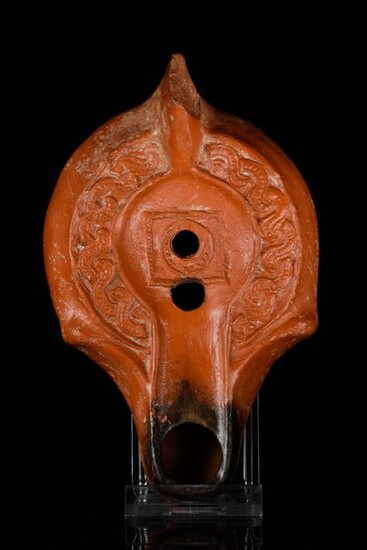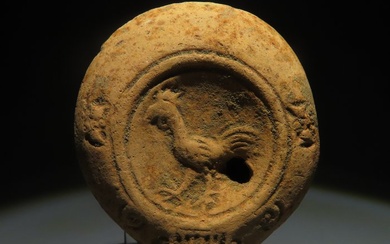Ancient Roman Terracotta Oil Lamp with Decoration - Original Paperwork
Ca. 400-500 AD. Late Roman. A wonderfully preserved, mould-made terracotta lamp in the style created in Roman North Africa. It has a rich, deep red colour and displays blackened deposits on the spout. The central sunken discus features a circle inscribed into a square and two pour holes and is surrounded by meandering bands in low relief; a wide channel runs down towards the nozzle. Excellent condition. During the Roman Empire, a lamp was originally called a 'lychnus' (from the Greek ‘λυχνοςÂ’) with the oldest Roman lamps dating back to the third century BC. It is thought that the Romans took the idea for lamps from the Greek colonies of Southern Italy. During the Roman Empire, it became commonplace to use lamps in funeral ceremonies and for public purposes. Over time, the manufacture of lamps increased, and so did the variation in decoration, which depended mainly on the shape and size of the lamp. Common decorative themes depicted on the discus were entertainment scenes (such as gladiators in combat) , common myths, and animals. During the fourth and fifth century AD, North Africa started to produce oil lamps from red slip, much like this fine example, with large discus areas which allowed for numerous designs. Cf. Zhuravlev, D. (2002) . Fire, light and light equipment in the Graeco-Roman world. Oxford: Archaeopress to find out more about light equipment across the Classical world. Size: L: 55mm / W: 135mm ; 152g. Provenance: Property of a North London gentleman C. M. ; formerly in Arnos Jumperz collection, Leverkusen (Germany) , acquired pre-1994.
[ translate ]View it on
Estimate
Time, Location
Auction House
Ca. 400-500 AD. Late Roman. A wonderfully preserved, mould-made terracotta lamp in the style created in Roman North Africa. It has a rich, deep red colour and displays blackened deposits on the spout. The central sunken discus features a circle inscribed into a square and two pour holes and is surrounded by meandering bands in low relief; a wide channel runs down towards the nozzle. Excellent condition. During the Roman Empire, a lamp was originally called a 'lychnus' (from the Greek ‘λυχνοςÂ’) with the oldest Roman lamps dating back to the third century BC. It is thought that the Romans took the idea for lamps from the Greek colonies of Southern Italy. During the Roman Empire, it became commonplace to use lamps in funeral ceremonies and for public purposes. Over time, the manufacture of lamps increased, and so did the variation in decoration, which depended mainly on the shape and size of the lamp. Common decorative themes depicted on the discus were entertainment scenes (such as gladiators in combat) , common myths, and animals. During the fourth and fifth century AD, North Africa started to produce oil lamps from red slip, much like this fine example, with large discus areas which allowed for numerous designs. Cf. Zhuravlev, D. (2002) . Fire, light and light equipment in the Graeco-Roman world. Oxford: Archaeopress to find out more about light equipment across the Classical world. Size: L: 55mm / W: 135mm ; 152g. Provenance: Property of a North London gentleman C. M. ; formerly in Arnos Jumperz collection, Leverkusen (Germany) , acquired pre-1994.
[ translate ]






